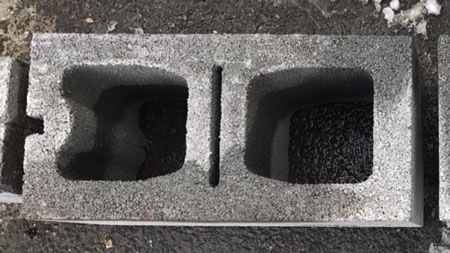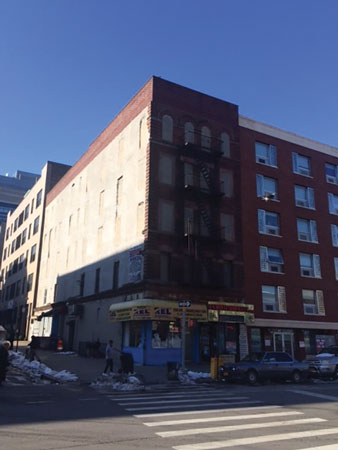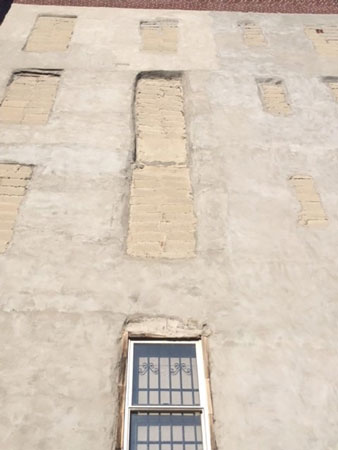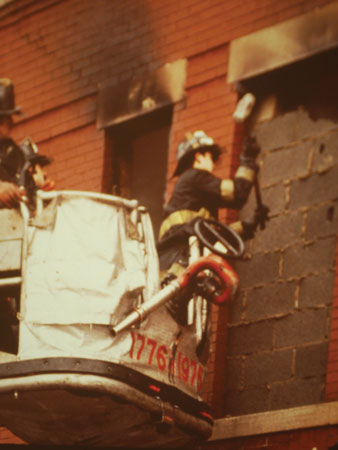
By Michael N. Ciampo
Vacant buildings are still very prevalent in many urban areas across the country. However, they’ve declined from years past in many cities, and it’s no longer an everyday occurrence to have to knock the cinder or concrete blocks out of a doorway or window of one of these buildings. Although that is a good thing, it’s also a bad thing that our skill set used in attacking these blocked-up beasts probably isn’t what it should be. That can also be true for knowing how and where to force or ventilate these openings, especially if we consider if they are on the ground level or on an upper floor.
Prior to performing our size-up of the blocks and the pattern in which they are laid out inside the opening, it’s imperative to know how the blocks are constructed. Usually, concrete blocks are made using Portland cement and an aggregate such as sand or fine gravel; in some instances, lighter weight blocks are made using an aerated concrete. The blocks have hollow centers or cores, which help reduce the weight and provide an advantageous area for attacking them. Most blocks in the United States measure 16 × 8 × 8 inches; but they may come in a variety of sizes and shapes and have from two to four cores. When the blocks are laid on top of one another, their joints are staggered, which makes the wall more rigid. If the cores are filled with concrete, it strengthens the wall, too. Luckily for us, most times the blocks are just placed in the openings, the cores are not filled, and no horizontal wire mesh is laid between the blocks. However, in some instances, the cores may be filled and mesh used for extra security.
Ground-Level Entry
When attacking a blocked-up window or a doorway, first size up the block layout pattern. Look specifically for the center of the block where the center rib or cross-section is. The block will be solid there. Strike it on either side of the center at the hollow core area to break the outer side. Usually, the best place to strike the wall is in your power swing area (like a baseball swing), just above your waist, which is about midway up in the door frame or window frame. Once you have broken the first block’s outside sections, the center rib is now exposed. Next, strike and eliminate this vertical section of block and then break through the back side of the block. Once you’ve broken through the first block, remember that you have removed a section of support; be aware that a collapse could occur during your next swings.
 |
| (1) This block has two cores with two inner support ribs. Striking the block at the hollow portions will make it crumble and fail more easily. (Photos 1-4 by Mike LaBarck.) |
Next, attack a block on either side of this one and work in line toward the ends. Some firefighters prefer to work in one direction; others may alternate from side to side of the original block. You’ll soon notice that the top section of the blocks is weakening and is now unsupported. Always use caution from the initial strike, watching the entire opening to see how sturdy the wall is. Removing or just hitting one block could cause a section or the entire wall to collapse if it’s not secured well in the opening.
Once you have removed a few blocks and the wall section above has become unsupported, all you have to do usually is push in on one of the blocks in the line of blocks just above your opening. If the blocks seem substantially secured, swing at a block in the middle to loosen it. Usually on removing that block, the remaining upper blocks will collapse or cave in. Always use caution when they collapse; they can fall inward or outward and will hurt you if they land on the top of your boot where there is no steel toe to protect your foot.
When swinging the tool, attack the blocks at the middle and not near the edge so you won’t waste a swing by hitting the frame of the window or door with the tool. During this operation, be aware that any broken blocks, small pieces of mortar, or other debris on the ground present a slip hazard. When performing this tactic, always ensure that you have solid footing; if you need to move some pieces of debris on the ground, do so prior to swinging. Firefighters have lost their footing and balance and have been injured during the swing by striking their hand, fingers, or arm on the wall, window, or door frame. Also, whenever you have to reposition your body while swinging the tool, ensure you have solid footing.
 |
| (2) These two blocks are narrower and have three cores, requiring more effort to forcibly remove them from the opening. |
Once you have made your initial purchase in the wall, attack the upper hanging blocks before attacking the lower blocks in the opening so you don’t have an unsupported section dangling overhead while you are working. Also, if you started to knock out the lower sections first, the vibrations of the tool striking the blocks could cause a collapse of the remaining upper blocks, which could fall and hit you.
Once the lower section is freestanding, striking or pushing in/pulling out on the top row will release the blocks in the lower portion of the opening. Removing all the blocks in the entire opening reduces the chance that an upper block will fall on you when you enter or that you will trip over a piece of block when stepping over the lower section.
Often, you will encounter these blocked-up door frames at the top of a stoop. After forcing entry through the blocks and gaining entry into the building, the broken pieces are all over the stairs like marbles. Quickly use your boots to slide the debris to one side and make a clear pathway up the stairs. This will enhance your entry into the building and reduce your chances of rolling an ankle while climbing the stairs. Also, it will reduce the chances that the butt end of a hoseline will get snagged on a block, delaying the stretch and getting water on the fire.
 |
| (3) Firefighters must size up the fire escape’s structural integrity to see whether they can use it to work from, to gain entry, or to ventilate the building. |
Upper Floor Entry Using a Tower Ladder
Often, we will encounter a vacant building with all its windows blocked up, requiring us to force them open. A tower ladder bucket is perhaps one of the safest areas from which to perform this tactic. The conditions encountered on arrival or as reported from the interior units (e.g., a small rubbish fire or fire on numerous floors) may determine how many floors we must open up.
One main concern is that if we have to open up each floor, we should start from the top and work downward. If we open up the lower floors first, we may possibly expose the members operating in the bucket to zero-visibility work conditions and to the heat and gases from the smoke venting from the openings below. Also, if the fire lights up below the bucket, it could melt the hydraulic or electrical lines and endanger the firefighters operating in the bucket.
Of course, every fire in these buildings is different; it could demand that we open up only a specific floor, but we need to be of the mindset that fire could spread rapidly in these rundown structures. So our game plan may include opening the whole place up for better overall interior operations and for rapid exterior stream placement to numerous floors. In addition, it offers our members more avenues of emergency egress if conditions inside the structure become unfavorable.
 |
| (4) A size-up of the structure’s blocked-up windows shows a possible problem between the third and fourth floor. The large interconnected section of blocks could mean a structural deficiency exists in the exterior wall or on the floors. |
Whenever forcing open these blocked-up windows on the upper floors, radio Command so he can inform all units. Flying pieces of concrete blocks and debris falling from numerous floors endanger all firefighters on scene; wear all of your personal protective equipment to reduce the chance of injury. The command staff should have direct communication to the members operating in the bucket to halt their operations if firefighters must enter the building with additional hoselines, perform another operation below, or bring out a squatter from the interior. Do not operate directly below the bucket to avoid injury from falling block or debris, and maintain a safety zone around the area below the tower ladder bucket.
Although minor pieces of block and mortar may fall downward when you are striking the blocks, the main objective of the members operating in the tower ladder bucket is to keep the material from falling into the street. Firefighters should always attack the top row of blocks first when operating out of the bucket. Knock through the first block in the same manner as when operating from the ground (sides first, center rib next, and finally back section). When knocking the first block inward, listen to hear whether the debris hits the floor. If you don’t hear the debris hitting the floor, no floor may be present at all and the blocks may fall numerous stories and could strike members operating inside the structure on the floors below. It could also mean there is no floor present under the window. If entering this window, always sweep and sound for a floor prior to entering.
Once you knock this top block inward, continue operating on the top row. Push or strike the next block on its free end; hopefully, it will twist inward or loosen. It may break or be loosened up more and can be pushed inward. Always remember that this may free the entire section, which could collapse quickly inward or outward to the street below. Once you have removed the top row, continue pushing or striking in the next row of blocks below the top until all the blocks are completely removed from the opening. Never pull the blocks outward; one block or the entire wall may fall and strike an unsuspecting member operating below.
 |
| (5) Tower ladders provide a good, safe, and stable platform when firefighters must open up blocked-up windows. Firefighters operating in the bucket must wear the installed safety belts. (Photos 5-6 by Matt Daly.) |
Bucket Placement
When you place the tower ladder bucket near these openings, try to keep on the windward side so the escaping smoke goes in the opposite direction when the window is ventilated. Keep this in mind when you choose which side of the building’s wall to work on. Placing the bucket’s lip or ledge up against the wall may allow you to catch pieces of the block and mortar and limit what falls to the street. The varying heights and sizes of the opening being ventilated or forced and a firefighter’s physical reach and size will determine where the bucket is positioned. Usually, having the upper railing below your work area will allow you to swing an ax or a sledgehammer without fear of the handle or your hand hitting the bucket’s railing. Always maintain a position slightly below the opening when working so you are not exposed to escaping heat, gases, smoke, or fire. Always wear installed safety belts for overall safety while operating in the bucket. In the past at vacant building fires, cornices, brickwork, or other ornamental features have detached from the structure and struck members operating in the tower ladder bucket. Wearing their safety belts prevented them from being ejected from the bucket.
 |
| (6) Attacking the top course of blocks and working downward when operating in the tower ladder bucket reduce the chances of the entire blocked section’s falling outward and downward toward members operating below. |
Vacant buildings have numerous types of security devices installed to prevent people from entering them. They require firefighters to perform aggressive forcible entry tactics to gain entry and extinguish the fire inside. Knowing the proper ways to accomplish these tasks, whether operating from the ground or in a tower ladder bucket, will assist firefighters in handling fires in these structures in a safer manner.
MICHAEL N. CIAMPO is a 31-year veteran of the fire service and a lieutenant in the Fire Department of New York. Previously, he served with the District of Columbia Fire Department. He has a bachelor’s degree in fire science from John Jay College of Criminal Justice in New York City. He is the lead instructor for the FDIC Truck Essentials H.O.T. program. He wrote the Ladders and Ventilation chapters for Fire Engineering’s Handbook for Firefighter I and II (Fire Engineering, 2009) and the Bread and Butter Portable Ladders DVD and is featured in “Training Minutes” truck company videos on www.FireEngineering.com.
Michael N. Ciampo will present “Tower Ladder Operations: Tower Above the Rest” at FDIC International in Indianapolis Thursday, April 27, 2017, 3:30 p.m.-5:15 p.m.
It’s Just a Vacant
Developing Response Guidelines for Fires in Vacant Buildings
FIGHTING FIRES IN VACANT OCCUPANCIES
Fire Engineering Archives

